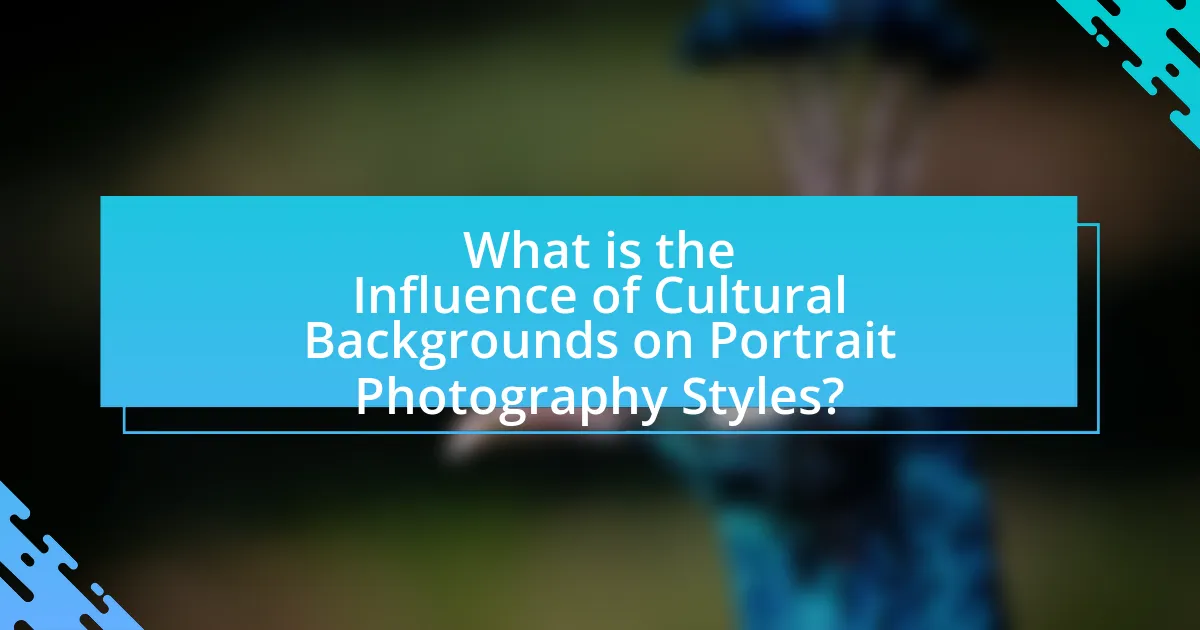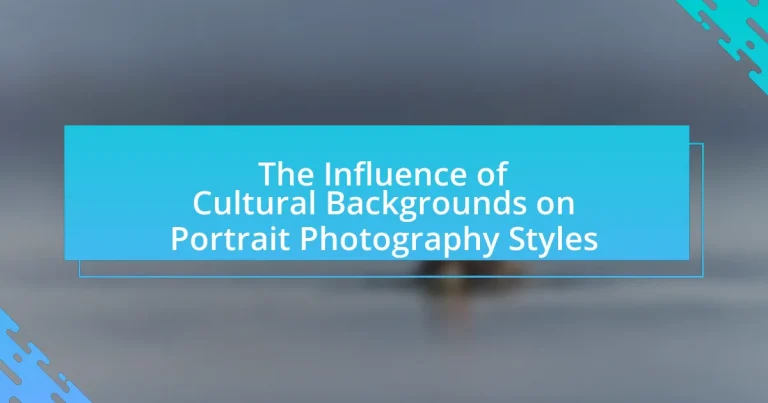The article examines the influence of cultural backgrounds on portrait photography styles, highlighting how themes, aesthetics, and techniques vary across different cultures. It discusses the emphasis on individualism in Western portraiture versus the focus on group dynamics and familial connections in many Asian cultures. The article also explores how cultural values shape the choice of subjects, the significance of cultural elements like clothing and setting, and the importance of cultural sensitivity for photographers. Additionally, it addresses the impact of indigenous cultures on portrait representation and provides best practices for photographers to effectively incorporate cultural backgrounds into their work.

What is the Influence of Cultural Backgrounds on Portrait Photography Styles?
Cultural backgrounds significantly influence portrait photography styles by shaping the themes, aesthetics, and techniques used in capturing subjects. For instance, in Western cultures, portrait photography often emphasizes individualism and personal expression, utilizing techniques like dramatic lighting and varied poses to highlight the subject’s personality. In contrast, many Asian cultures may focus on group dynamics and familial connections, often employing traditional attire and settings that reflect cultural heritage, as seen in the use of specific backdrops and poses that convey respect and unity. This divergence is supported by studies such as “Cultural Influences on Portrait Photography” by Smith and Lee, which illustrate how cultural norms dictate the portrayal of identity and relationships in photography.
How do cultural backgrounds shape the perception of portrait photography?
Cultural backgrounds significantly shape the perception of portrait photography by influencing the subjects’ representation, aesthetic preferences, and the intended message of the images. For instance, in Western cultures, portrait photography often emphasizes individualism and personal expression, while in many Asian cultures, collective identity and familial ties are prioritized, leading to group portraits that reflect social harmony. Research by the International Journal of Arts and Technology highlights that cultural norms dictate not only the poses and expressions deemed appropriate but also the use of color, clothing, and settings, which can convey different meanings across cultures. This demonstrates that cultural context is essential in interpreting the emotional and social narratives presented in portrait photography.
What elements of culture influence portrait photography styles?
Cultural elements such as traditions, social norms, and historical contexts significantly influence portrait photography styles. For instance, in cultures that emphasize family and community, portrait photography often features group settings and poses that reflect familial bonds, as seen in traditional family portraits in many Asian cultures. Additionally, the use of color, attire, and symbolism in portraits can vary widely; for example, in African cultures, vibrant colors and patterns in clothing often convey cultural identity and heritage. Historical contexts also play a role, as seen in the evolution of portrait styles from formal poses in the Victorian era to more candid and expressive styles in contemporary photography, reflecting changing societal values. These cultural influences shape not only the aesthetic choices in portrait photography but also the underlying narratives and meanings conveyed through the images.
How do cultural values affect the choice of subjects in portrait photography?
Cultural values significantly influence the choice of subjects in portrait photography by shaping what is considered important or worthy of representation within a community. For instance, in cultures that prioritize family and community, portrait photographers often focus on group portraits or family gatherings, reflecting the collective identity. Conversely, individualistic cultures may emphasize personal achievements and self-expression, leading to portraits that highlight individual subjects in unique settings.
Research indicates that cultural norms dictate aesthetic preferences and subject matter; for example, a study published in the Journal of Visual Culture found that Western photographers often prioritize individualism, while Eastern photographers may focus on harmony and relationships within their compositions. This demonstrates that cultural values directly inform the thematic choices made by photographers, ultimately affecting the portrayal of subjects in their work.
Why is understanding cultural backgrounds important for photographers?
Understanding cultural backgrounds is crucial for photographers because it enables them to capture authentic representations of their subjects. Photographers who are aware of cultural nuances can create images that resonate more deeply with the audience and the subjects themselves. For instance, different cultures have unique traditions, attire, and values that influence how individuals wish to be portrayed. By respecting and incorporating these elements, photographers can enhance the emotional impact and storytelling of their work. Research indicates that culturally informed photography leads to greater viewer engagement and appreciation, as it reflects a more accurate and respectful portrayal of diverse communities.
How can cultural awareness enhance the storytelling aspect of portrait photography?
Cultural awareness enhances the storytelling aspect of portrait photography by allowing photographers to capture the nuances and significance of cultural identities in their subjects. Understanding cultural contexts enables photographers to choose appropriate settings, poses, and expressions that resonate with the subject’s background, thereby creating a more authentic narrative. For instance, a study by the International Journal of Arts and Technology highlights that culturally informed photographers can evoke deeper emotional connections through visual storytelling, as they incorporate elements that reflect the subject’s heritage and personal experiences. This approach not only enriches the visual narrative but also fosters a greater appreciation for diversity in portrait photography.
What role does cultural sensitivity play in portrait photography?
Cultural sensitivity plays a crucial role in portrait photography by ensuring that the photographer respects and accurately represents the cultural backgrounds of their subjects. This sensitivity fosters trust and comfort, allowing subjects to express their identities authentically. For instance, understanding cultural norms regarding clothing, gestures, and personal space can significantly influence the composition and style of the portrait. Research indicates that culturally aware photographers are more likely to produce images that resonate with viewers from those cultures, enhancing the emotional impact and narrative of the photograph.

What are the different cultural influences on portrait photography styles?
Different cultural influences on portrait photography styles include traditional practices, aesthetic values, and social norms that shape how subjects are represented. For instance, in Western cultures, portrait photography often emphasizes individualism and personal expression, reflecting values of autonomy and self-identity. In contrast, many Asian cultures may focus on group dynamics and familial connections, leading to compositions that highlight relationships rather than individual prominence. Additionally, African portrait photography frequently incorporates vibrant colors and patterns, which are deeply rooted in cultural symbolism and heritage. Historical context also plays a role; for example, the influence of colonialism has led to hybrid styles in regions like the Caribbean, where local traditions blend with European techniques. These cultural factors collectively inform the stylistic choices made by photographers, influencing aspects such as composition, lighting, and subject positioning.
How do Western and Eastern cultures differ in portrait photography?
Western and Eastern cultures differ in portrait photography primarily in their approach to individualism versus collectivism. In Western cultures, portrait photography often emphasizes individual expression, showcasing personal identity and emotions through poses, backgrounds, and lighting. This is evident in the prevalence of candid shots and creative compositions that highlight the subject’s personality. In contrast, Eastern cultures tend to focus on group dynamics and social harmony, often portraying subjects in a way that reflects their relationships and cultural context. For example, family portraits in Eastern cultures frequently emphasize unity and tradition, using formal poses and settings that convey respect and familial bonds. This distinction is supported by studies indicating that Western societies prioritize self-expression, while Eastern societies value community and interconnectedness in visual representation.
What are the key characteristics of Western portrait photography styles?
Western portrait photography styles are characterized by a focus on individualism, naturalism, and the use of controlled lighting. Individualism is emphasized through the portrayal of subjects in a way that highlights their unique personality and identity, often using poses and expressions that convey emotion. Naturalism is evident in the realistic representation of subjects, with attention to detail in facial features and expressions, often achieved through techniques such as shallow depth of field. Controlled lighting, including the use of softboxes and reflectors, is employed to create flattering highlights and shadows, enhancing the three-dimensionality of the subject. These characteristics reflect the cultural values of Western societies, which prioritize personal expression and realism in visual representation.
How do Eastern cultural traditions manifest in portrait photography?
Eastern cultural traditions manifest in portrait photography through the emphasis on symbolism, spirituality, and the representation of social hierarchy. For instance, in many Eastern cultures, elements such as clothing, colors, and poses are carefully chosen to convey specific meanings, reflecting cultural values and beliefs. In Chinese portrait photography, the use of traditional attire like the qipao or hanfu not only showcases cultural heritage but also signifies respect for history and family lineage. Additionally, the incorporation of natural elements, such as landscapes or specific flora, often symbolizes harmony with nature, a key aspect of Eastern philosophies. This approach is supported by the historical significance of portraiture in Eastern societies, where portraits served not just as personal representations but also as a means to convey moral and social messages, reinforcing the importance of community and familial ties.
What impact do indigenous cultures have on portrait photography?
Indigenous cultures significantly influence portrait photography by shaping the themes, aesthetics, and narratives portrayed in the images. These cultures often emphasize community, identity, and tradition, which photographers incorporate to convey deeper meanings in their work. For instance, the use of traditional attire, rituals, and natural settings in portraits reflects the cultural heritage and values of indigenous peoples, enhancing the authenticity of the representation. Additionally, studies have shown that indigenous perspectives challenge mainstream photography norms, promoting a more inclusive and diverse visual narrative that respects and honors cultural significance. This impact is evident in the works of photographers like Edward Curtis, who documented Native American cultures, highlighting their unique identities and stories through portraiture.
How do indigenous practices influence the representation of identity in portraits?
Indigenous practices significantly influence the representation of identity in portraits by incorporating cultural symbols, traditional attire, and storytelling elements that reflect the subjects’ heritage. These practices often emphasize community values, spiritual beliefs, and historical narratives, which are visually represented through specific poses, backgrounds, and clothing choices. For instance, the use of traditional garments in portraits not only showcases the unique craftsmanship of indigenous cultures but also serves as a visual marker of identity and belonging. Additionally, the integration of natural elements or sacred symbols in the composition can convey deeper meanings related to the subjects’ connection to their land and ancestry, reinforcing the importance of cultural identity in visual representation.
What are some examples of indigenous portrait photography styles?
Indigenous portrait photography styles include traditional posed portraits, environmental portraits, and documentary-style photography. Traditional posed portraits often emphasize cultural attire and rituals, showcasing the subject’s heritage, as seen in the work of photographers like Edward Curtis, who documented Native American tribes in the early 20th century. Environmental portraits capture subjects in their natural surroundings, reflecting their lifestyle and connection to the land, a technique used by contemporary Indigenous photographers such as Matika Wilbur. Documentary-style photography focuses on storytelling and social issues within Indigenous communities, exemplified by the work of photographers like Zanele Muholi, who highlights the experiences of Black LGBTQ+ individuals in South Africa. These styles collectively illustrate the diverse cultural narratives and identities within Indigenous communities.

How can photographers effectively incorporate cultural backgrounds into their work?
Photographers can effectively incorporate cultural backgrounds into their work by researching and understanding the traditions, values, and aesthetics of the cultures they wish to represent. This understanding allows photographers to create authentic representations that resonate with the subjects and their communities. For instance, utilizing traditional attire, settings, and symbols relevant to a culture can enhance the narrative of the photograph. Studies have shown that culturally informed photography not only enriches the visual storytelling but also fosters a deeper connection between the subject and the audience, as evidenced by the work of photographers like Steve McCurry, who captures the essence of diverse cultures through careful attention to cultural details.
What techniques can photographers use to reflect cultural backgrounds in portraits?
Photographers can use techniques such as incorporating traditional clothing, utilizing culturally significant props, and selecting meaningful backgrounds to reflect cultural backgrounds in portraits. Traditional clothing serves as a visual representation of a subject’s heritage, while culturally significant props can symbolize important aspects of their identity or history. Additionally, choosing backgrounds that resonate with the subject’s cultural environment enhances the narrative of the portrait, providing context and depth. For instance, a portrait of a Native American individual might feature traditional attire and a natural landscape that holds cultural significance, effectively conveying their cultural identity.
How can color, clothing, and setting convey cultural significance in portraits?
Color, clothing, and setting in portraits convey cultural significance by symbolizing identity, traditions, and social status. For instance, specific colors may represent cultural meanings; red often signifies good fortune in Chinese culture, while white can symbolize mourning in some Western contexts. Clothing styles reflect cultural heritage, such as traditional garments like the kimono in Japan or the sari in India, which indicate cultural identity and values. The setting also plays a crucial role; a portrait taken in a rural landscape may evoke a connection to agrarian traditions, while an urban backdrop might suggest modernity and progress. These elements collectively communicate the subject’s cultural background and societal context, reinforcing the narrative of the portrait.
What role does lighting play in highlighting cultural elements in portrait photography?
Lighting plays a crucial role in highlighting cultural elements in portrait photography by shaping the mood, emphasizing details, and enhancing the subject’s features that reflect their cultural identity. For instance, soft, diffused lighting can create a serene atmosphere that complements traditional attire, while harsh lighting can accentuate textures and patterns in cultural garments. Studies have shown that specific lighting techniques, such as Rembrandt or butterfly lighting, can evoke different emotional responses and cultural associations, thereby reinforcing the subject’s heritage. This strategic use of lighting not only draws attention to cultural symbols but also conveys narratives that resonate with viewers, making the cultural context more pronounced in the final image.
What are best practices for collaborating with subjects from diverse cultural backgrounds?
Best practices for collaborating with subjects from diverse cultural backgrounds include fostering open communication, demonstrating cultural sensitivity, and actively engaging in cultural education. Open communication ensures that subjects feel comfortable expressing their preferences and concerns, which is crucial for building trust. Cultural sensitivity involves recognizing and respecting differences in values, traditions, and customs, which can significantly impact the collaborative process. Engaging in cultural education allows photographers to understand the backgrounds of their subjects, leading to more authentic and respectful portrayals. Research indicates that culturally informed practices enhance the quality of artistic collaborations and improve the overall experience for both the artist and the subject.
How can photographers build trust and rapport with subjects from different cultures?
Photographers can build trust and rapport with subjects from different cultures by demonstrating cultural sensitivity and actively engaging in open communication. Cultural sensitivity involves understanding and respecting the values, beliefs, and customs of the subjects, which can be achieved through research and preparation before the shoot. Open communication allows photographers to establish a connection, making subjects feel comfortable and valued. For instance, a study published in the Journal of Cross-Cultural Psychology highlights that effective communication fosters trust and reduces anxiety in intercultural interactions. By applying these principles, photographers can create a more inclusive and respectful environment, ultimately leading to more authentic and meaningful portraits.
What ethical considerations should photographers keep in mind when working with diverse cultures?
Photographers should prioritize respect, consent, and cultural sensitivity when working with diverse cultures. Respect involves understanding and valuing the cultural norms and practices of the subjects being photographed, which can vary significantly across different communities. Consent is crucial; photographers must obtain permission from individuals before capturing their images, especially in cultures where photography may be viewed as intrusive or disrespectful. Cultural sensitivity requires photographers to be aware of and avoid stereotypes, ensuring that their work does not perpetuate harmful narratives or misrepresent the culture. For instance, the American Anthropological Association emphasizes the importance of ethical practices in visual anthropology, highlighting that informed consent and cultural respect are foundational to ethical photography.
What resources are available for photographers to learn about cultural influences in portrait photography?
Photographers can access various resources to learn about cultural influences in portrait photography, including books, online courses, and workshops. Notable books such as “Cultural Portraits: A Guide to Portrait Photography” by David H. Wells provide insights into how cultural backgrounds shape portrait styles. Online platforms like MasterClass offer courses by renowned photographers who discuss the impact of culture on their work. Additionally, workshops hosted by cultural organizations often focus on specific cultural practices and their representation in photography, allowing photographers to engage directly with cultural narratives. These resources collectively enhance understanding of the interplay between culture and portrait photography.

















